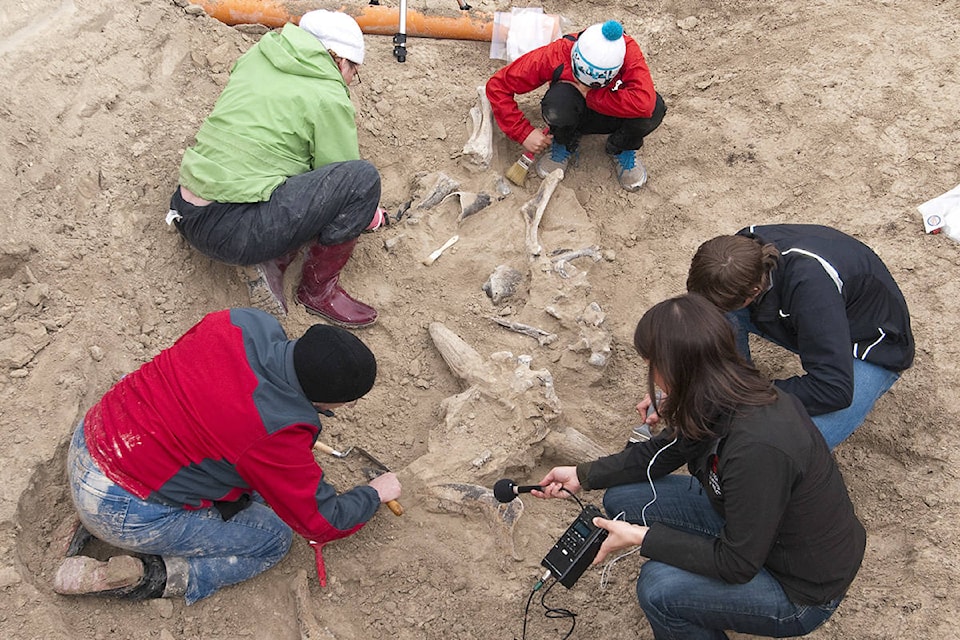Five millennia ago, a young male bison had an unfortunate accident in what is now Porter Creek, getting stuck in a lake, torn apart by carnivores, then buried in silt.
A new paper published by NRC Research Press sheds new light on the life and times of the partial skeleton of the now-extinct steppe bison that was found in the backyard of a private residence in Whitehorse in 2012. That animal, which was approximately six years old, became mired in a lake and died, then was “partially scavenged by carnivores” before being “buried by… silt sediment” in the middle Holocene period, the paper reads.
“It was a little bit like CSI,” said Grant Zazula, a paleontologist with the Yukon government and the paper’s lead researcher. “It sort of becomes a detective story — what’s the scene of the crime, how did this animal die, what were the causes, how did it live?”
The findings from the study of the specimen “book-end our understanding” of steppe bison, said Zazula. The genetics of the specimen, taken from core samples from the horns, show that the animals persisted into a “relatively modern era.”
The data shows that the northern steppe bison survived the late Pleistocene extinction event, approximately 11,000 years ago, which saw nearly 75 per cent of all large mammals in North America disappear, the paper states. The species persisted locally in the southern Yukon into the present era, known as the Holocene.
An analysis of the area where the bison skeleton was found revealed that it was once dominated by white spruce, a species now almost non-existent in the Yukon, said Zazula. This means that the landscape was probably more woodland than the plains-type environment we typically associate with bison.
“It shows that this is a species that can really change and adapt very quickly,” Zazula said.
Steppe bison are thought to have migrated from Asia into North America via the Bering Strait between 195,000 and 135,000 years ago. Once here, they rapidly colonized and began to “dominate” the mammalian megafauna landscape, and lived from Alaska to Mexico, said Zazula.
While they look quite similar, steppe bison were “actually quite different than modern bison,” Zazula said. Steppe bison were larger and heavier with a thicker skull plate and much larger, more powerful horns than their modern descendants, which persisted and evolved from ice-age steppe bison in more southern climates.
Despite these physiological differences, very little has changed on a genetic level, evolutionarily speaking, said Zazula. Modern bison could “absolutely” breed with steppe bison, if they were still alive today.
Two populations of wood bison presently exist in the Yukon — the Aishihik herd, near Haines Junction, and the bison along the Alaska Highway, which typically skirt the British Columbia-Yukon border near Watson Lake — but neither of these populations are directly descended from steppe bison. Rather, they are introduced populations of wood bison. Only the Aishihik herd is huntable.
The last known evidence of steppe bison in the Yukon comes from a bone found at Annie Ned Creek in Haines Junction, which is about 400 years old. The specimen found in Porter Creek is a link in that population in the Yukon.
“Genetically, the (Annie Ned Creek specimen) is the same as this guy (from Porter Creek),” said Zazula.
This raises the question of what actually caused this species of bison to go extinct in the Yukon, when they had survived for so long and many other animals had gone died out. A climate event is one possibility, said Zazula, although it seems unlikely, since the steppe bison had already survived the ice age.
Over-hunting has also been suggested as one option, but there is little evidence that bison were a major food source for First Nations in the Yukon the way they were further South. Yukon First Nations during this period tended to rely more on caribou and, later, on moose, Zazula said, although why exactly is unknown. Few examples of bison skeletons with butchering-marks appearing in the sample base, he said.
Disease has been suggested as another possible cause, but in reality, paleontologists “just don’t know” what made the animals die out, Zazula said.
“The key thing about bison is how adaptable they are … to actually kill them off entirely 400 years ago is very significant,” he said.
“It furthers the need to understand the mystery.”
Contact Lori Fox at lori.fox@yukon-news.com
